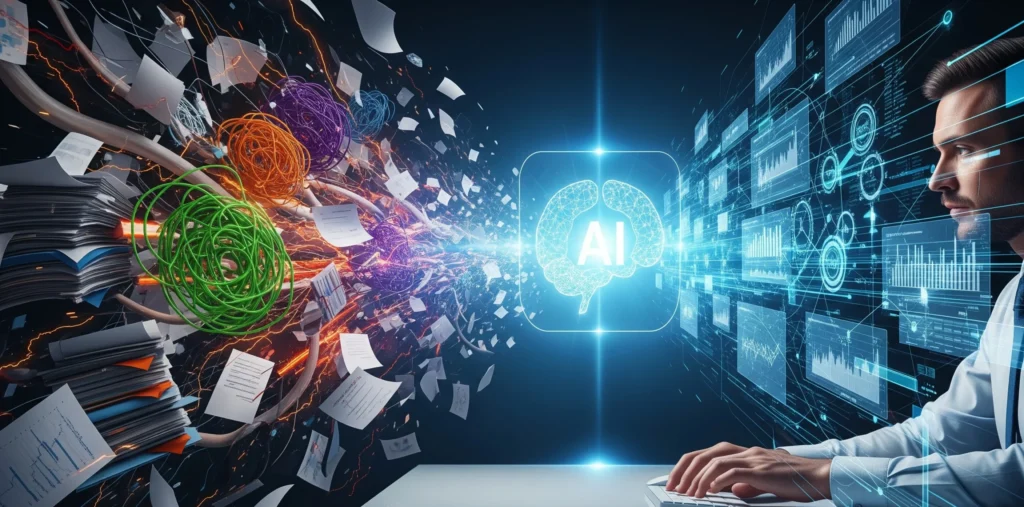Let’s cut to the chase. You’ve heard the big names—IBM, Microsoft, McKinsey—all talking about AI-powered transformation. You’ve seen the impressive statistics on productivity gains and the promises of a new era. But if you’re like most professionals, you’re left with a single, burning question: “How do I actually do it?”
The truth is, business transformation isn’t a magical leap; it’s a strategic, step-by-step journey. As someone who has spent decades watching industries evolve, I can tell you that the difference between talk and action is a solid blueprint. This guide isn’t a corporate report—it’s a practical, hands-on playbook for leveraging AI to boost your productivity and fundamentally transform your business.
We’re going to cut through the jargon, debunk the myths, and give you the actionable steps you need to not just compete, but dominate in the AI-powered landscape of 2025.
The Problem: The Transformation Trap
Why do so many companies struggle with AI transformation? The issue isn’t a lack of technology; it’s a lack of strategy. The “transformation trap” is the belief that simply buying an AI tool will magically solve your problems. It won’t.

Instead of a cohesive strategy, many businesses end up with a collection of fragmented tools. The result is more complexity, not more productivity. Our goal is to move you from this reactive, fragmented approach to a proactive, integrated one.
The Big Shift: From Manual to AI-Augmented
The core of business transformation is not replacing people with machines, but empowering people with intelligence. This table breaks down what that shift looks like in a practical sense.
| Traditional Business Model | AI-Augmented Business Model |
| Data Silos | Unified Data Lake: AI integrates data from all sources to give you a single source of truth. |
| Reactive Decisions | Predictive Insights: AI analyzes historical data to forecast trends and inform proactive decisions. |
| Manual Processes | Automated Workflows: AI handles repetitive tasks like data entry, scheduling, and customer support. |
| Generic Engagement | Hyper-Personalized Experience: AI segments customers and personalizes every interaction, from emails to product recommendations. |
| Human-Only Analysis | Human-AI Collaboration: AI provides rapid data analysis, while humans focus on strategic interpretation and problem-solving. |
The Solution: Three Pillars of AI-Powered Transformation
True transformation relies on building a robust foundation. These three pillars will be your guide.

1. AI for Automation: The Productivity Engine
This is the most direct path to productivity gains. AI excels at handling the mundane, repetitive tasks that drain your team’s energy. Don’t think about replacing jobs; think about liberating your people to focus on the unique skills that drive innovation in businesses across India.
- Intelligent Automation: Use AI tools to automate everything from scheduling meetings and managing invoices to qualifying leads and generating reports. Explore platforms like UiPath for robust automation capabilities. Our guide on best AI agents for automation can help you find the right tools.
- Customer Support: Deploy AI chatbots to handle 80% of routine customer queries, freeing your human team to focus on complex, high-value problems, leading to happier customers right here in Ahmedabad and beyond. Learn how in our guide on AI chatbots for customer service. Consider platforms like Intercom for integrating AI-powered customer support.
- Content Creation: AI can generate first drafts, analyze SEO keywords (crucial for reaching your local audience online), and even create social media copy, cutting content production time by a significant margin. Explore this in our post on AI writing tools for long-form content. Tools like Surfer SEO can help optimize AI-generated content for local search.
2. AI for Insight: The Competitive Advantage
This is where you move from working harder to working smarter. AI’s ability to process vast amounts of data is your key to unlocking a competitive edge in the increasingly competitive Indian marketplace.
- Data Analysis: Stop relying on gut feelings. AI can analyze sales data, customer feedback (even in local languages), and market trends in real-time to give you actionable insights relevant to your specific region. Our guide on AI data analysis tools for non-technical users is a great starting point. Explore tools like Tableau for powerful data visualization powered by AI insights.
- Financial Forecasting: AI can predict future revenue, identify financial risks (considering local economic factors), and model different business scenarios with a level of accuracy no human could match. For small businesses across Gujarat, this is crucial—read our guide on AI financial forecasting for small businesses. Consider platforms like SAS Forecast Server for sophisticated financial predictions.
3. AI for Innovation: The Future-Proofing Strategy
AI isn’t just about efficiency; it’s about creating entirely new business models and services. This is the long-term play that separates market leaders from the rest.
- Personalization at Scale: Use AI to create personalized product recommendations, marketing campaigns, and user experiences that build customer loyalty.
- Agile Development: AI is transforming software development by writing code, debugging, and testing. It allows small teams to develop and deploy products at a pace previously only possible for large corporations.
- Creative Media: From generating video scripts to composing original music, AI is a partner in creative innovation. Learn more in our post on AI music composition tools for beginners.
The AI Revolution Is Underhyped | Eric Schmidt | TED
This video features former Google CEO Eric Schmidt and provides a compelling, high-level perspective on why AI is so transformative. It directly addresses the “future of work” and the massive opportunities and challenges, making it a perfect complement to your strategic blog post.
FAQs: Your Guide to AI Transformation
Is AI transformation only for large companies?
Not at all. In fact, a recent report from McKinsey noted that companies of all sizes are investing in AI. Small and medium-sized businesses can leverage cloud-based AI tools to gain the same advantages as large corporations without the massive upfront investment.
Will AI replace my job?
This is a common and valid concern. The consensus among experts, including Sam Altman of OpenAI, is that AI will not replace human jobs entirely. Instead, it will change the nature of our work, automating repetitive tasks and allowing us to focus on more complex, creative, and strategic problems that require a human touch.
How do I get started with AI in my business?
Start small. Identify a single, time-consuming task—like writing social media posts or qualifying sales leads—and find an AI tool designed to automate it. From there, you can scale your AI implementation and expand to other areas of your business.
Conclusion: The Human Advantage
The data shows that AI is no longer optional. It is the core driver of productivity and business transformation in 2025. But this isn’t a race between humans and machines. It’s an opportunity for human ingenuity to be freed from the constraints of busywork.
The path to a more productive, innovative, and resilient business is paved with AI. The tools are accessible, the strategy is clear, and the future is yours for the taking.
Now it’s your turn: What’s the one task in your business you’d love to transform with AI? Share your thoughts below!
